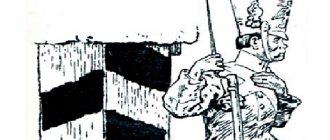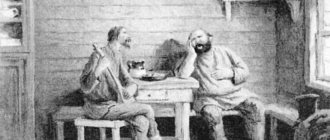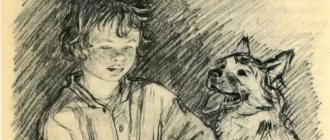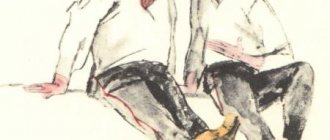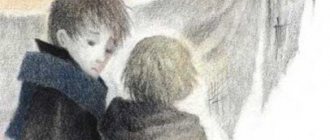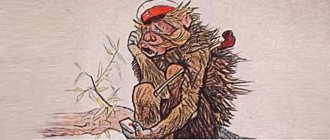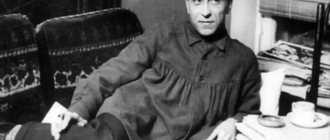"The Little Prince" and its author
The Little Prince is the story of a young boy traveling through the universe. He not only visits one planet after another, but also searches for the secret of friendship, the essence of love and the meaning of existence. He tries to understand not only the world around him, but also himself. Self-knowledge is his main task. The boy is still developing, he personifies the tender and innocent years of childhood, which is why the writer called him “little.”
But for what reason is the prince? He lives on his own planet himself, this entire territory belongs only to him. He responsibly fulfills his economic role and, despite his childhood, has already learned to care for his own land. This behavior suggests that the reader is looking at a prudent young man who rules his planet, but what else can you call him? A prince, because he is endowed with power and wisdom.
Antoine de Saint-Exupery , being a military pilot, was involved in a plane crash on one of his flights; this happened in 1936 in the desert in Libya. News of the beginning of the war, memories of a plane crash and the awakening of hidden psychological childhood traumas inspired Antoine de Saint-Exupéry to create a fairy tale.
The fairy tale was written in 1942 in America, a year later it was already available for reading. The book was the last creation of the writer and brought Exupery worldwide popularity.
The dedication of the book to his childhood friend ( Leon Werth ) was not done by chance. He was a Jew who suffered persecution during World War II. He (like the little prince) was forced to leave “his planet” - his homeland. Such a dedication was not just a tribute to friendship, but also a bold challenge from the writer to anti-Semitism and Nazism.
The fairy tale "The Little Prince" has been translated from French into 360 languages . Since 2021, France has been celebrating the Day of the Little Prince every year. This decision was made by the Antoine de Saint-Exupéry Foundation on the occasion of the 120th anniversary of the writer's birth ( June 29, 1900 ) to pay tribute to his novel.
Prince - who is he?
The Little Prince is the personification of the child who lives inside every adult. a living, creative and caring soul, which with age is not allowed to live. They become overgrown with small problems, stop appreciating nature and the people around them, think that they know everything, lose curiosity and interest in everything that happens. Neighboring asteroids are the same high-rise buildings to which people return after work. Monotonous, not knowing what their neighbor’s name is. An example of an adult who has not yet lost his inner child, remembers in his dreams, is the Artist.
The Prince's childish soul also carries within it the ability for self-sacrifice - he must at all costs watch over and care for his Rose, because he has tamed her.
Two worlds in the story
Two worlds are presented in the fairy tale “The Little Prince” - adults and children. In this work, the division is not made according to age. For example, the pilot is an adult, but he managed to preserve his childish soul. The author divides people according to ideals and ideas. For adults, the most important things are their own affairs, ambition, wealth, power.
But a child’s soul yearns for something else – friendship, mutual understanding, beauty, joy. Antithesis (children and adults) helps to reveal the main conflict of the work - the confrontation between two different systems of values: real and false, spiritual and material. It goes deeper further. Having left the planet, the little prince meets “strange adults” on his way, whom he is unable to understand. [4]
The main characters and their characteristics
1. The Little Prince is a partially autobiographical image, although it is very difficult to imagine that an adult pilot was once a little dreamer. The main character is a little boy, but at the same time he very often turns out to be smarter than adults who “really love numbers.” Exupery endowed his hero with seemingly incompatible qualities: spontaneity and reliability. He is kind and very fond of his Rose , who remained on his planet. At the same time, he is still growing and does not know many things. For example, he learned friendship only on planet Earth, and realized his love only after separation.
2. Rose. The prototype of Rosa was the author’s wife, Consuelo , a Latina with a fiery disposition. The rose was a special flower, the little prince would have recognized it among thousands of other roses; all other flowers were “empty” for him. The rose was fragile and vulnerable, so the boy covered it with a glass cover. But the character of this lady was explosive and capricious: she addressed her interlocutor imperiously and often insisted on something of her own.
3. The pilot plays the role of narrator in the work. Despite the fact that he is an adult and experienced, the man instantly finds a common language with the Little Prince. This is because in childhood he was different from other people, and even later he did not find a way to understand them and become the same as them. He just adapted to their ways. The author showed the misunderstanding through the drawings and their interpretation. The narrator drew one thing, but those around him saw something else. As a result, he lost faith in himself and stopped drawing and became a pilot. But the guest from another planet immediately understood him. This instilled hope in the pilot’s heart that it was not he who was mediocre, but that everyone else did not understand him. Thus, before us is a person of fine spiritual organization, sensitive to criticism and able to value spiritual kinship.
4. The fox is a wild animal who became a true friend to the Little Prince . It was he who taught him responsibility for the one he tamed. Wise advice and moral teachings often slip from his lips; this is probably a universal image of a mentor whom each of us meets sooner or later on our path.
5. Business man. The business man owned the fourth planet. As an analysis of the fairy tale “The Little Prince” shows, the meaning of his life was that one should find something that does not have an owner and appropriate it. A business man counts wealth that is not his: he who saves only for himself might as well count the stars. The little prince cannot understand the logic by which adults live. He concludes that it is good for his flower and the volcanoes that he owns them. But the stars have no benefit from such possession. [4]
6. Lamplighter. Only on the fifth planet does the main character find a person with whom he wants to make friends. This is a lamplighter who would be despised by everyone, because he thinks not only about himself. However, his planet is tiny. There's no room for two here. The lamplighter works in vain because he doesn’t know for whom [4], but it was him who the Little Prince singled out among all those he met on different planets:
“Here is a man,” the Little Prince said to himself, continuing on his way, “here is a man whom everyone would despise - the king, the ambitious, the drunkard, and the businessman. And yet, of all of them, he is the only one, in my opinion, who is not funny. Maybe because he thinks not only about himself . [2, chapter 14, p. 57]
King, Business Man and Lamplighter. © SNEG5.com
To describe briefly, during his travels the Little Prince met “strange adults”:
1. Ambitious , whose main goal is to be admired.
2. A ruler confident in his unconditional power over all planets.
3. A business person - his main occupation is counting asteroids.
4. A drunkard who drinks because he feels guilty for drinking alcohol, no matter how paradoxical this may sound.
5. A geographer who, in his entire life, has never seen anything other than his own star.
6. Lamplighter , who constantly lit and extinguished the lantern.
The last place was Earth, where he found a true friend.
A bit of irony
In modern Russian, the word “prince” has an ironic meaning: this is what they usually say about a person who tends to be mannered when communicating or, on the contrary, to act in an emphatically formal manner. Nowadays, there is a parable about an elderly and lonely woman who has been waiting all her life for the ideal prince. People asked her: “Have you met such a person?” The woman replied, “Oh, yes!” But people did not stop: “So what?!” The woman sighed and answered: “He was looking for the ideal woman...”
Waiting for a miracle misses the opportunity to change your life, build a relationship with a real man and learn to be happy in our far from ideal world.
Topics and issues
1. Exupery in the fairy tale “The Little Prince” talks about many global problems. First of all, he is concerned about the question of the meaning of life . This is exactly what the little traveler is looking for the answer to, making his way through outer space. It is obvious that most of his neighbors do not reach the essence of existence, they simply live within the usual framework and do not go beyond the limits of small and unhappy worlds. Only the main character dared to go further and look into his own soul. After all, in communicating with the inhabitants of the Earth, he understood and admitted his mistakes, and in the finale he returned to Rose .
2. The author also talks about love, friendship and responsibility . Exupery not only revealed the theme of friendship or love, but also conveyed to the reader the importance of responsibility for a loved one, and for the world as a whole. The hero worked every day, defending his planet, cleaning it and caring for it. He also loved and cherished Rose ; it was only through his care that she remained alive.
Exupery
the problem of all-consuming evil using the example of baobabs, which, if not eradicated, will consume all living things. This is a symbol of any parasitism on Earth. You need to live by your own labor, and not attack foreign lands, eradicating all living things. The description of the life activity of baobabs is the embodiment of the anti-war theme, because in the image of aggressive trees one can easily see Hitler’s army.
4. In his work, Exupery acutely poses the problem of loneliness , which he knew about first-hand while sitting in the cockpit. To show loneliness, the author places the pilot in the desert, but, as the Little Prince , you can be lonely among people. This problem is more relevant in modern society than ever.
5. Theme of mind and feelings. Through the mouth of the Fox, Exupery is trying to convey to the reader that you cannot see everything with your eyes, “only the heart is vigilant,” as the Fox . [5]
Artistic Features
Each edition of "The Little Prince" is accompanied by the author's illustrations, which explain the content of the book and enrich it. The author expresses his vision of the world through simple drawings familiar to every person. They became more popular than the work itself.
The book consists of detailed metaphors and allegories. Thus, the inhabitants of lonely planets represent popular human types and misconceptions. The king of the asteroid is a dwarf despot who consoles himself with the illusion of power and might, although in reality he does not influence anything. This is exactly what many government officials are like. ambitious people on the vastness of social networks, and Exupery probably found them everywhere in the bohemian environment, where it is customary to admire oneself and not notice others. The business man, always busy with calculations , is a portrait of a typical businessman who measures everything in numbers and forgets to live in his desire for calculations. The geographer is a hopeless theorist who does nothing of what he claims to know.
The composition of “The Little Prince” is very interesting: “a story within a story” allows the reader to be in two realities at once - in the desert with a pilot and in space with the little prince. [5]
A little about friendship
Saint-Exupéry about friendship on the first page of the story (in the dedication). In the author's system of values, the theme of friendship occupies one of the main places. Only friendship can melt the ice of loneliness and alienation, since it is based on mutual understanding, mutual trust and mutual assistance.
“It’s sad when friends are forgotten. Not everyone has a friend ,” says the hero of the fairy tale.
At the beginning of the fairy tale, the Little Prince leaves his only Rose , then he leaves his new friend Fox on Earth. “There is no perfection in the world ,” says the Fox . But there is harmony, there is humanity, there is a person’s responsibility for the work entrusted to him, for the person close to him, there is also responsibility for his planet, for everything that happens on it.
The Little Prince and the Fox. © SNEG5.com
Exupery claims that nothing can interfere with the friendship of a person with a person and other living beings, except the person himself. Everyone wants to be tamed. the Little Prince about this , he even teaches him how to do it, teaches him tenderness and gradualism, loyalty and perseverance, caution (because you are afraid to frighten off the nascent feeling of the one you are taming) and determination.
- My life is boring. I hunt chickens, and people hunt me. All chickens are the same, and all people are the same. And my life is a bit boring. But if you tame me, my life will be illuminated as if by the sun. I will begin to distinguish your steps among thousands of others. When I hear people's steps, I always run and hide. But your walk will call me like music, and I will come out of my hiding place. <…> And how wonderful it will be when you tame me! Golden wheat will remind me of you. And I will love the rustle of the ears of corn in the wind... The fox fell silent and looked at the Little Prince for a long time. Then he said:
- Please... tame me! [2, chapter 21, p. 76]
The fox reveals to the Little Prince the secret of taming: to tame means to create bonds of love and unity of souls. Both the prince and the Fox need this friendship equally. And the Little Prince needed her even more, because it was the Fox who taught him to love.
Rose is a symbol of love, beauty, femininity
The Fox taught the Little Prince that “love cannot be abstract, love is always concrete,” and explained this (to him and to the readers) using the example of the Little Prince’s love for Rose. The Little Prince has a kind heart and a reasonable view of the world. He is hardworking, faithful in love and devoted in feelings.
Antoine de Saint-Exupéry says that people must learn to trust each other and take responsibility for everything they love. The meaning of the book lies in the phrase:
“Loving does not mean looking at each other, it means looking in the same direction.”
Consuelo Sunsin and Antoine de Saint-Exupéry
Exupery shows the problem of relationships between men and women through the relationship between the Little Prince and Rose. Moreover, in real life it is a reflection of the relationship between the author and his wife. Living together is not easy, especially if the characters do not match. But true love inspires people to self-denial, makes them take care of each other, no matter what happens. [5]
The talking rose appears to us in the form of a beautiful flower, which bloomed only after a long time, due to “unsuitable” living conditions. The seed fell on the child’s planet by accident, which is why the rose was in a terrible mood for a long time and refused to bloom. The heroine constantly criticizes the boy and asks for comprehensive help in protecting him from the wind, weather conditions and wild animals and insects, although they have never been on the prince’s planet.
Despite the rose's bad character, the boy tries in every possible way to please her, fulfilling all her whims. Only when the main character gets ready to go on a trip does the selfish person soften and sincerely wish happiness to her savior, confessing her love to him. When the boy leaves, the rose asks him not to look at her, because tears of remorse for what he did flowed down the petals of the flower.
And only on Earth did the Little Prince learn what true love and friendship are. And the meaning of life, a person’s calling, is in selfless love for those who need it. And the Little Prince returns to his asteroid to take care of his only Rose, who will die without him.
"Snow White and the Seven Dwarfs"
Disney princesses and princes are controversial characters in many ways. Often viewers criticize their actions and stories, accusing the creators of implausibility. The couple from Snow White and the Seven Dwarfs received a lot of mixed reviews. This is due to the fact that the prince and princess did not know each other, but only met once before he saved her from the witch's spell.
We remind you that the prince first appears in the cartoon when Snow White was singing near the well. He drove past the castle and heard a beautiful voice that made him stop. At first he listened to the girl's song, and then began to sing along. The appearance of the stranger frightened the princess, and she ran into the house. Then the prince began to sing a serenade for Snow White, which made her go out onto the balcony.
The hero's name was never mentioned in the cartoon, but it is known that the prince's name is Ferdinand. He has brown hair and blue eyes.
"Mermaid"
Many people are so in love with fairy tales that they buy dolls of Disney princes, princesses and other heroes. One of the most beloved and colorful couples are the characters from the cartoon “The Little Mermaid.”
A human prince named Eric becomes the lover of the princess of the underwater world. The guy has broad shoulders and muscular arms. He has thick black hair and blue eyes.
In everyday life, Eric looks the same as all ordinary sailors, which is very unusual for a prince. The guy differs from others in his sincere and kind character. He first appears before the audience on the ship where his birthday is celebrated. Soon a storm begins and the ship breaks up. Eric rushes to save his dog, as a result of which he himself falls into a trap. This is witnessed by the little mermaid Ariel, who pulls the guy ashore.

